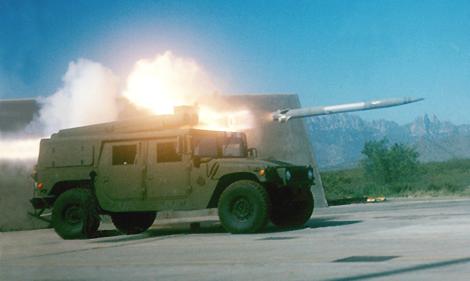Lockheed Martin MGM-166 LOSAT/KEM
In 1988, the U.S. Army initiated the LOSAT (Line-of-Sight Anti-Tank) program as part of the general AAWS-H (Advanced Anti-Tank Weapon System - Heavy) development effort. LOSAT was a vehicle-mounted anti-armour guided missile system, which used a hypervelocity "hit-to-kill" missile. That missile was usually known by the acronym KEM (Kinetic Energy Missile). Initial contractors were LTV and Texas Instruments, who offered a derivative of LTV's HVM (Hypervelocity Missile). LOSAT tests began in June 1990, but in 1992 the program was reduced to Technology Demonstration status, and in 1996 the DOD recommended the termination of the program. However, after an appeal by the U.S. Army, LOSAT was reinstated in November 1997 as an ACTD (Advanced Concept Technology Demonstration) program. The ACTD contract was awarded to Lockheed Martin, which had by then acquired the missile division of Loral Vought (successor to LTV). In 2002, the designation MGM-166A was allocated to the KEM.
In its latest configuration, LOSAT was mounted on a modified HMMWV (High Mobility Multipurpose Wheeled Vehicle), designated M1114 (some sources say M1113 or M1044A1). The vehicle was armed with four ready-to-fire KEMs on the top, and eight more could be towed behind in a resupply container. The LOSAT gunner had a FLIR (Forward-Looking Infrared)/TV sensor to find and designate targets, and LOSAT's fire control system (FCS) could acquire, track and engage two targets simultaneously. After launch, the MGM-166A rapidly accelerated to 1500 m/s (5000 fps) and reached maximum range in less than 5 seconds. It was inertially guided along its flight path, with targeting updates provided by the FCS as necessary. The KEM had no explosive warhead and destroyed the target's armour only with its kinetic energy. LOSAT was designesd as a very quick reaction system, and a whole acquisition/lock-on/fire sequence could be completed within a few seconds.
 |
| Photo: Lockheed Martin |
| MGM-166A |
In August 2002, Lockheed Martin received the first production contract for 108 MGM-166A missiles. The missiles equipped the Army's first tactical LOSAT unit with twelve HMMWV fire units during 2003. In March 2004, LOSAT's Developmental Test program was successfully completed and a decision about the start of LRIP (Low Rate Initial Production) was then expected for later that year. However, at that time it was already clear that the Army wanted to terminate LOSAT procurement after the first LRIP batch (about 435 missiles), because the intended successor (CKEM - Compact Kinetic Energy Missile) was already in development. In the end no production funds were allocated, and the program was terminated in the summer of 2004.
Specifications
Note: Data given by several sources show slight variations. Figures given below may therefore be inaccurate!
Data for MGM-166A:
| Length | 2.85 m (9 ft 3 in) |
| Diameter | 16.2 cm (6.4 in) |
| Weight | 80 kg (177 lb) |
| Speed | 1500 m/s (5000 fps) |
| Range | > 4000 m (13000 ft) |
| Propulsion | Solid-fueled rocket |
| Warhead | none ("hit-to-kill") |
Main Sources
[1] Hajime Ozu: "Missile 2000 - Reference Guide to World Missile Systems", Shinkigensha, 2000
[2] Lockheed Martin Missiles and Fire Control Website
[3] GlobalSecurity.org Website
[4] Army Technology Website:
"LOSAT Line-of-Sight Anti-Tank Weapon",
Net Resources International Ltd.
[5] Department of Defense Missile Nomenclature Records
Back to Current Designations Of U.S. Unmanned Military Aerospace Vehicles
Back to Directory of U.S. Military Rockets and Missiles
Last Updated: 6 December 2004